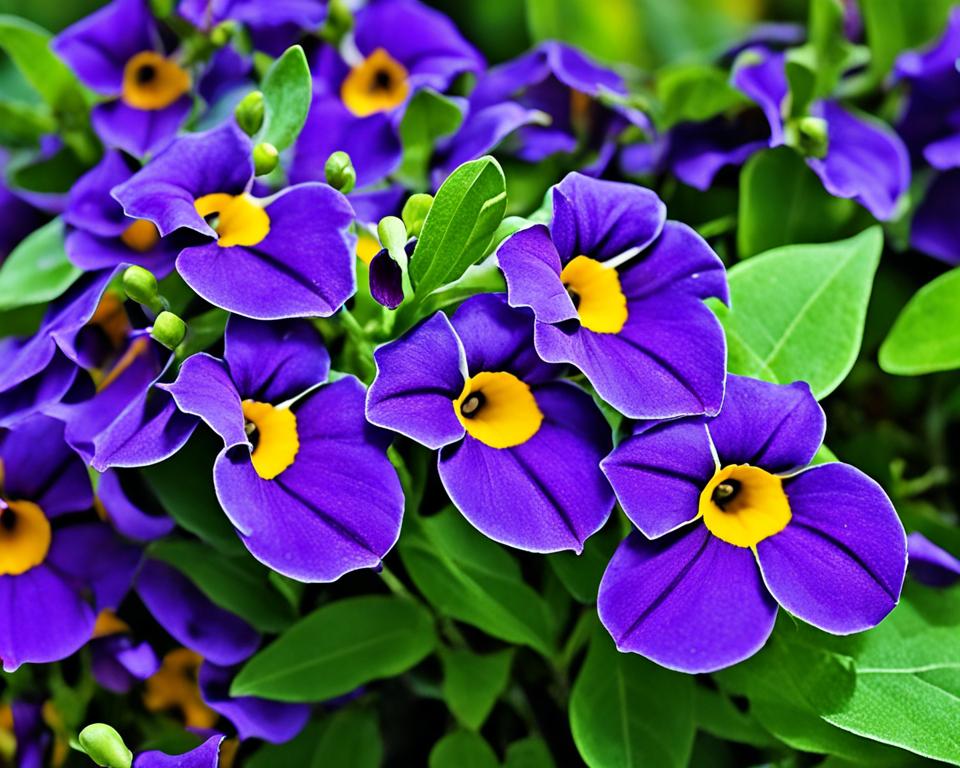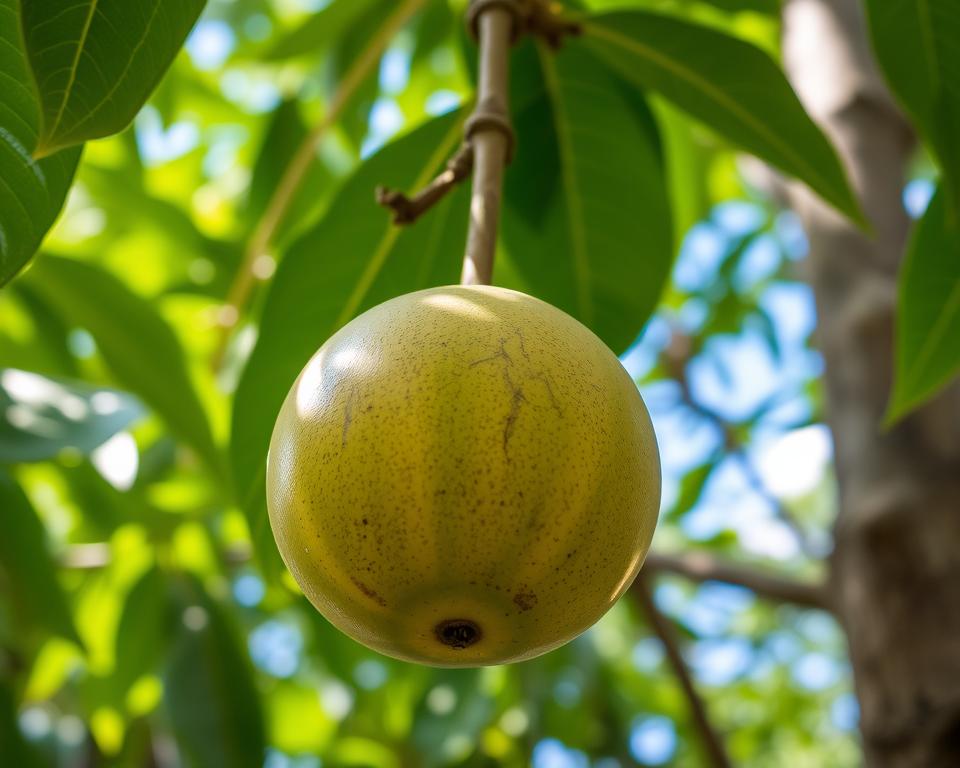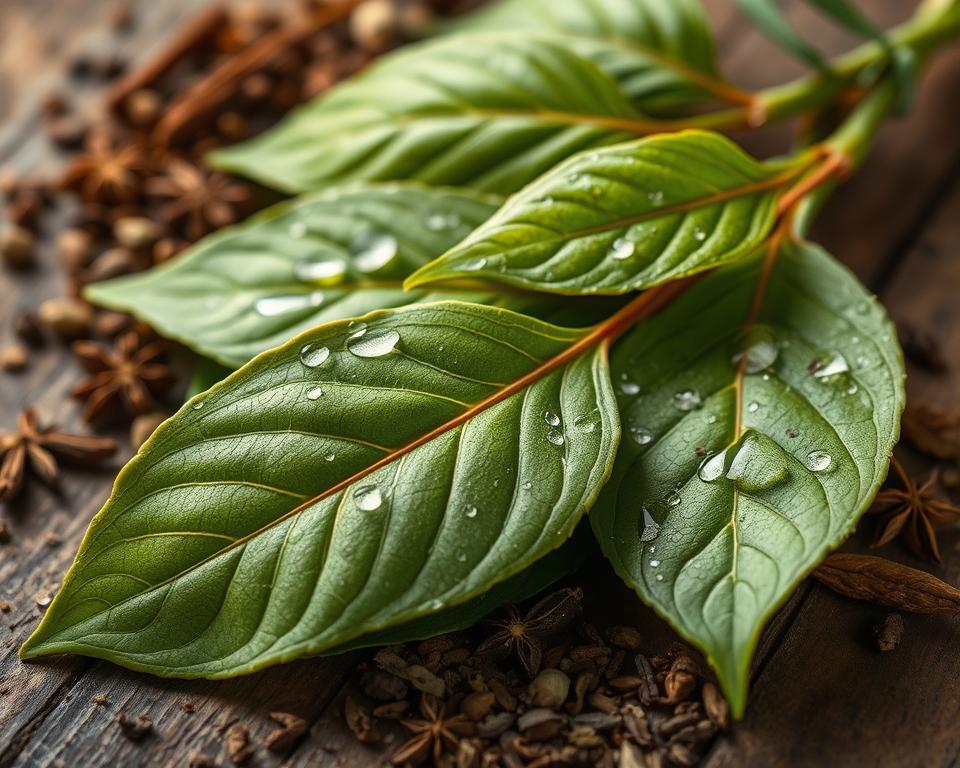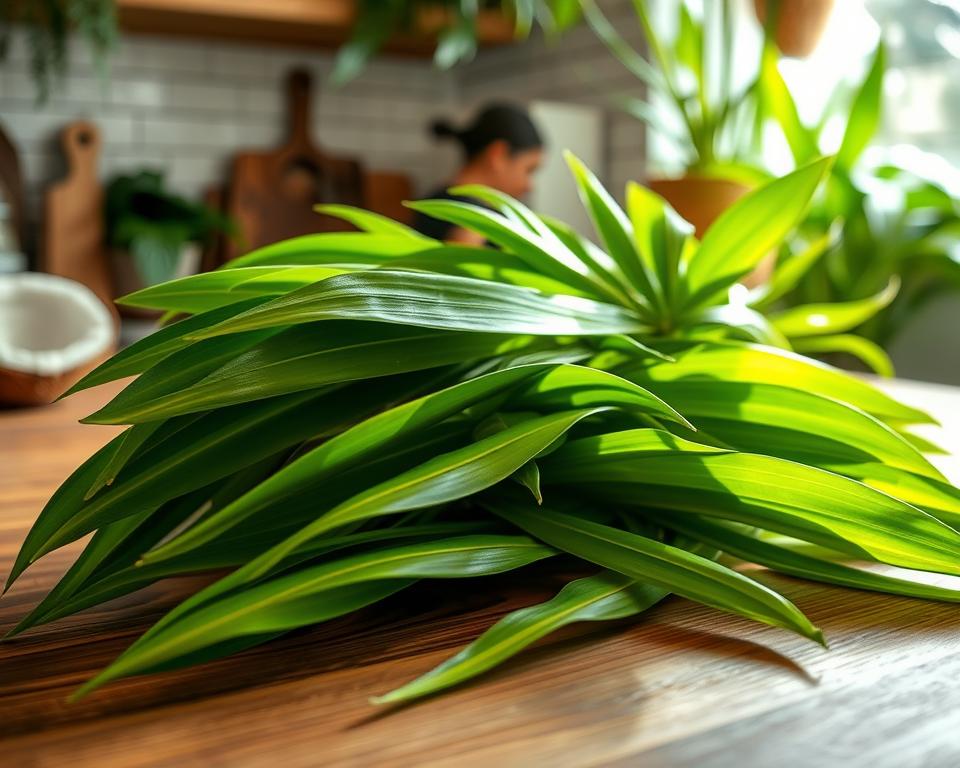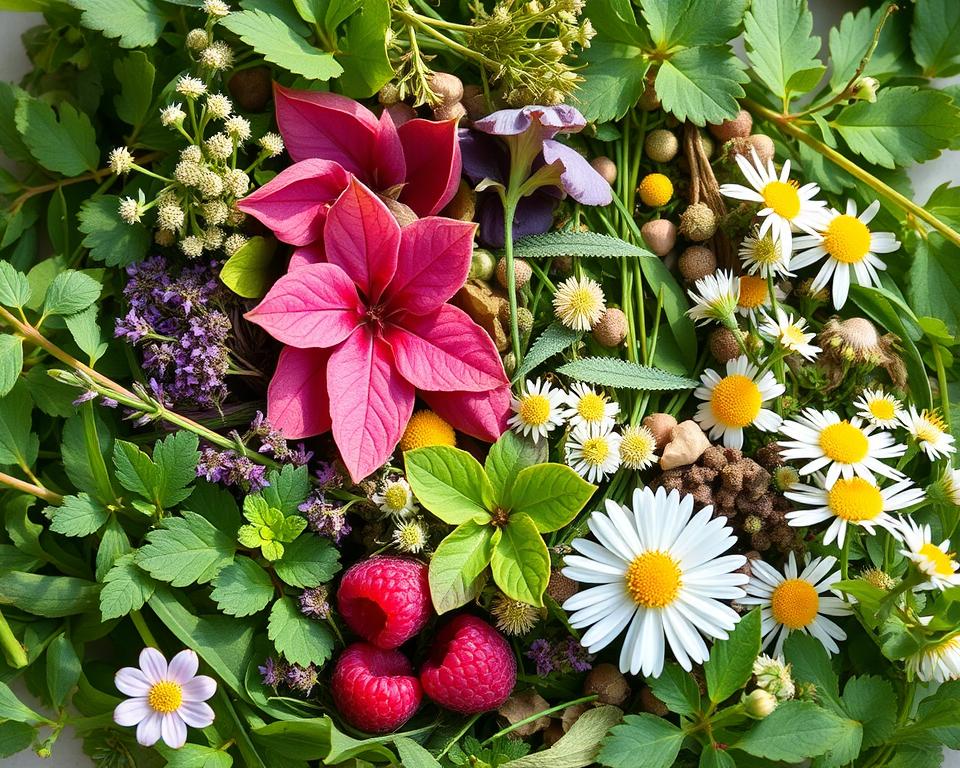Thunbergia laurifolia, also known as the purple glory vine, is a stunning tropical vine. It has vibrant purple flowers shaped like trumpets. This plant is native to parts of Asia and is loved for its beauty and health benefits.
It’s used in landscaping and traditional medicine. In this article, we’ll look at the many benefits and uses of this amazing plant. We’ll cover its botanical features, ideal growing conditions, and how it adds beauty to gardens worldwide.
Read interesting things at : tosawakan
Key Takeaways
- Thunbergia laurifolia is a beautiful tropical vine with striking purple trumpet-shaped flowers.
- It is known by various names, including the purple glory vine, purple glory tree, and laurel-leaved clockvine.
- The plant is valued for its ornamental appeal, medicinal properties, and versatile landscaping applications.
- Thunbergia laurifolia thrives in warm, tropical climates and requires specific growing conditions to flourish.
- This captivating vine offers a range of benefits, from its stunning blooms to its potential therapeutic uses.
Introducing Thunbergia laurifolia
Thunbergia laurifolia, known as the purple glory vine or laurel-leaved clockvine, is a stunning tropical vine. It comes from Southeast Asia and is loved for its big leaves and bright purple flowers.
Botanical Overview and Nomenclature
The name Thunbergia laurifolia comes from Carl Peter Thunberg, a Swedish botanist, and the Latin word laurifolius, meaning laurel-like leaves. This tropical woody vine is also called blue thunbergia and large-leaved clockvine.
This vine can grow up to 30 feet long and has a woody stem. Its leaves are big and shaped like an oval. The flowers are trumpet-shaped and a beautiful purple color, brightening up any garden or landscape.
“Thunbergia laurifolia is a captivating tropical plant that combines stunning foliage and vibrant blooms, making it a true delight for gardeners and nature enthusiasts alike.”
| Scientific Name | Thunbergia laurifolia |
|---|---|
| Common Names | Purple glory vine, laurel-leaved clockvine, blue thunbergia, large-leaved clockvine |
| Family | Acanthaceae |
| Native Range | Southeast Asia |
| Growth Habit | Perennial, woody vine |
| Leaf Size | Up to 12 inches (30 cm) long |
| Flower Color | Purple, trumpet-shaped |
Distinct Features of the Purple Glory Vine
The Thunbergia laurifolia, also known as the large-leaved clockvine or laurel clockvine, is a unique vine. It has lush, dark green leaves that can reach up to 8 inches long. These leaves have a leathery and glossy texture, making them stand out among other vines.
The vine’s main attraction is its vibrant purple flowers. These flowers look like elegant trumpets and cluster together, creating a beautiful sight. The purple glory vine’s unique leaves and bright flowers make it a great choice for gardens in warm climates.
| Feature | Description |
|---|---|
| Leaf Size | Up to 8 inches long |
| Leaf Texture | Leathery and glossy |
| Flower Color | Vibrant purple |
| Flower Shape | Trumpet-like |
| Flower Arrangement | Clustered |
The large-leaved clockvine’s lush foliage and the laurel clockvine’s striking purple flowers make it a standout plant. It’s perfect for adding beauty to warm-weather gardens or landscapes.
Thunbergia laurifolia: A Warm-Climate Wonder
Thunbergia laurifolia, also known as the laurel-leaved clockvine or the purple glory vine, is a true warm-climate plant. It thrives in USDA hardiness zones 9-11, where the climate is warm and humid all year.
Ideal Growing Conditions
The warm-climate vine needs full sun and well-draining soil to grow well. It’s perfect for gardeners in subtropical and tropical areas. There, it grows easily with little care.
This tropical woody vine likes soil rich in organic matter and slightly acidic to neutral pH. It can handle drought but grows best with regular water. This keeps it healthy and full of flowers.
“Thunbergia laurifolia is a true delight for gardeners in warm, humid climates, offering a striking visual display with its vibrant purple blooms.”
With its beautiful leaves and stunning flowers, Thunbergia laurifolia is a must-have for tropical or subtropical gardens. It loves the warm, humid weather, making it a great choice for gardeners in the right areas.
Breathtaking Blooms: The Purple Trumpet Flowers
The Thunbergia laurifolia, or purple trumpet vine, is known for its stunning purple trumpet-shaped flowers. These flowers come in clusters, drawing bees and hummingbirds to them. They make any space look beautiful.
The flowers’ deep purple color adds a tropical feel to gardens. Their unique trumpet shape grabs attention. This makes the purple trumpet vine a favorite for decorative gardens and arbors.
“The purple trumpet flowers of the Thunbergia laurifolia are a true showstopper, transforming any space into a botanical masterpiece.”
These flowers bloom in spring and summer, offering long-lasting beauty. The blue thunbergia variety adds a unique blue-violet color to gardens.
The purple trumpet vine can climb or spread as a groundcover. It’s a versatile and beautiful addition to any garden. Its flowers will surely impress everyone who sees them.
Versatile Landscaping with Thunbergia laurifolia
The thunbergia laurifolia, also known as the purple glory vine, is perfect for warm climates. It’s great for ground covers because it trails beautifully. It also climbs well on trellises, arbors, or fences, adding height to gardens.
This vine’s lush leaves and bright purple flowers fit well in many garden spots. It can be part of mixed borders, containers, or the main attraction in tropical gardens. Its flexibility makes it a favorite among gardeners and landscapers.
Looking to add some fun to your patio or create a beautiful display on a trellis? The thunbergia laurifolia is a great pick. It can make any warm-climate garden look better.
Diverse Landscaping Applications
- Ground cover: The thunbergia laurifolia‘s trailing habit makes it perfect for covering bare ground. It adds a lush, textured look to landscapes.
- Vertical gardening: This vine climbs well on trellises, arbors, or fences. It adds height and elegance to gardens.
- Mixed borders: The thunbergia laurifolia‘s bright flowers and lush leaves blend well with other plants in borders.
- Container gardens: Growing this vine in containers adds color and a trailing look to patios or balconies.
- Focal points: Use the thunbergia laurifolia as a focal point in tropical gardens. It draws the eye and adds drama.
| Landscaping Application | Benefits |
|---|---|
| Ground cover | Adds a lush, textured look to the landscape |
| Vertical gardening | Enhances the vertical interest of the garden |
| Mixed borders | Seamlessly complements a variety of other plants |
| Container gardens | Adds a pop of color and a trailing element to patio or balcony spaces |
| Focal points | Draws the eye and adds a sense of drama to the landscape |
“The thunbergia laurifolia is a true chameleon of the plant world, able to transform any landscape with its versatile and captivating presence.”
Cultivation and Care Tips
Growing the thunbergia laurifolia, or purple glory tree, is a rewarding task for gardeners. This vibrant vine does well with the right conditions and care. Let’s look at the key points for cultivating this beautiful plant.
Soil Requirements and Planting Guide
Thunbergia laurifolia likes soil that drains well and is rich in nutrients. When you plant it, add organic matter to the soil to help with drainage and fertility. This makes a great home for the plant to grow. Make sure the vine gets full sun, as it loves bright sunlight.
- Well-draining, nutrient-rich soil
- Amend soil with organic matter
- Plant in full sun exposure
It’s important to stake or trellis the vine to support its growth and flowers. This keeps the plant from spreading out too much and keeps it looking neat. With the right care, thunbergia laurifolia will show off its purple glory year after year.
| Soil Type | Sunlight Requirement | Planting Tips |
|---|---|---|
| Well-draining, nutrient-rich | Full sun | Amend soil with organic matter, provide support for vine |
“With the right care, the thunbergia laurifolia will thrive and become a showstopping addition to any garden.”
Thunbergia laurifolia: Beyond the Garden
Thunbergia laurifolia, also known as the laurel-leaved clockvine or large-leaved clockvine, is more than just a pretty plant. It’s used in traditional medicine and crafts. Its leaves and flowers help with health issues, and its stems are used in making things.
This plant is not just for looks. In traditional medicine, its leaves and flowers treat many health problems. The leaves are known for reducing pain and inflammation, making them a go-to for pain relief.
| Traditional Uses of Thunbergia laurifolia | Potential Benefits |
|---|---|
| Pain relief | Anti-inflammatory properties |
| Skin conditions | Antimicrobial and wound-healing effects |
| Digestive issues | Antioxidant and anti-ulcer properties |
In some places, the stems of the large-leaved clockvine are used for crafts. They’re flexible and strong, perfect for making baskets, ropes, and small furniture.
“The versatility of Thunbergia laurifolia extends far beyond its captivating flowers, showcasing the plant’s potential to contribute to diverse aspects of human life.”
Looking into Thunbergia laurifolia shows it’s more than just a pretty face. It has health benefits and practical uses. This plant is a true marvel that deserves more study and respect.
Benefits of the Laurel-Leaved Clockvine
Thunbergia laurifolia, also known as the laurel-leaved clockvine, has a long history in Southeast Asia. It’s been used in traditional healing for its amazing healing powers.
Medicinal Properties and Traditional Uses
The leaves and flowers of the thunbergia laurifolia plant are packed with anti-inflammatory, pain-relieving, and antioxidant properties. People have used it to treat many health issues, such as:
- Skin conditions, such as eczema and psoriasis
- Digestive issues, including stomach ulcers and gastrointestinal disorders
- Fever and respiratory problems
- Headaches and other forms of pain
The plant’s active parts, like flavonoids and phenolic acids, help with healing. These substances are being studied for their anti-inflammatory and antioxidant effects. This makes thunbergia laurifolia important in both traditional and modern herbal medicine.
“The laurel-leaved clockvine has been revered for its medicinal properties in Southeast Asian cultures for centuries, offering a natural and holistic approach to wellness.”
| Medicinal Use | Traditional Applications |
|---|---|
| Anti-inflammatory | Treating skin conditions, reducing swelling and pain |
| Analgesic (pain-relieving) | Relieving headaches, muscle aches, and other types of pain |
| Antioxidant | Promoting overall health and well-being, neutralizing free radicals |
| Digestive health | Addressing stomach ulcers, diarrhea, and other gastrointestinal issues |
The laurel-leaved clockvine is still being studied and used today. It’s a fascinating plant for researchers and traditional healers.
Propagating the Purple Glory Tree
Thunbergia laurifolia, or the purple glory tree, is a beautiful tropical vine. It can be easily spread through different methods. Learning how to propagate it lets gardeners grow new plants and increase their collection of this lovely plant.
Seed Sowing
One way to spread thunbergia laurifolia is by sowing seeds. These seeds grow well in soil that drains well and is warm and humid. Planting them in early spring works best, letting the young plants get ready for the growing season.
Stem Cuttings
Another way to grow the purple glory tree is by using stem cuttings. Choose healthy stems and put them in a mix that drains well to root. This is great for gardeners who want plants that look just like their favorites.
Division of Rhizomes
You can also spread thunbergia laurifolia by dividing its rhizomes. These are the underground stems that help the vine grow. Dig up and separate the rhizomes, making sure each piece has roots, to create new plants.
Choosing how to propagate the purple glory tree matters, but so does taking good care of it. By learning how to spread thunbergia laurifolia, gardeners can enjoy the beauty of this tropical vine.

Common Pests and Diseases
The Thunbergia laurifolia, or purple glory vine, is tough but can face pests and diseases. Gardeners need to watch closely to keep this beautiful creeper healthy.
Aphids are a common problem for this plant. These tiny insects suck sap, slowing growth and making leaves look bad. To fight aphids, spray with insecticidal soap or add ladybugs to your garden.
Spider mites are another issue. They eat the plant’s leaves, leaving webs and color changes. Watch your plants closely and use miticides or water to control spider mites.
| Common Pests | Potential Diseases |
|---|---|
| Aphids | Fungal Infections |
| Spider Mites | Bacterial Leaf Spot |
| Caterpillars | Powdery Mildew |
The Thunbergia laurifolia can also get fungal and bacterial diseases. Fungal infections like powdery mildew make leaves look bad. Bacterial leaf spot causes spots on leaves. To prevent these, keep air moving and don’t water from above.
By watching for pests and diseases and acting fast, gardeners can keep their Thunbergia laurifolia plants healthy and beautiful.
Companion Plants for Thunbergia laurifolia
The thunbergia laurifolia, or Purple Glory Vine, looks great with many plants in warm, humid places. Picking the right plants makes the thunbergia laurifolia look even better.
The hibiscus is a great match for the thunbergia laurifolia. Its bright flowers and the thunbergia‘s purple blooms make a stunning view. The bougainvillea, with its bright colors, also works well. It can hang down and mix with the thunbergia for a beautiful look.
For a lush, tropical look, try pairing the thunbergia laurifolia with mandevilla or ipomoea. These plants add beauty and help your garden look together.
When picking plants for your thunbergia laurifolia, think about how they grow, how much sun they need, and how much water they want. This way, you can make a beautiful, balanced tropical garden.
Varieties and Cultivars of the Large-Leaved Clockvine
The traditional Thunbergia laurifolia is known for its purple trumpet-shaped flowers. But, gardeners can now choose from many cultivars with different colors. These include delicate white, vibrant yellows, and stunning bicolors. These Thunbergia varieties make it easy to add beauty to any garden.
Exploring Different Color Variations
The Thunbergia laurifolia, or large-leaved clockvine, comes in a wide range of flower colors. You can find cultivars with:
- Pure white flowers for a classic, elegant look
- Radiant yellow blooms that add a burst of sunshine to the garden
- Stunning bicolor varieties featuring a combination of colors, such as purple and white or yellow and white
These colors let gardeners match the Thunbergia laurifolia to their garden style. This way, they can create a garden that’s truly their own.
| Cultivar | Flower Color | Unique Features |
|---|---|---|
| Thunbergia laurifolia ‘Alba’ | White | Pure white blooms for a classic, elegant look |
| Thunbergia laurifolia ‘Aurea’ | Yellow | Vibrant yellow flowers that add a cheerful touch to the garden |
| Thunbergia laurifolia ‘Bicolor’ | Purple and White | Stunning bicolor blooms with a combination of purple and white |
With these many cultivars, finding the right Thunbergia laurifolia is easy. It’s a great way to match your garden with your style.
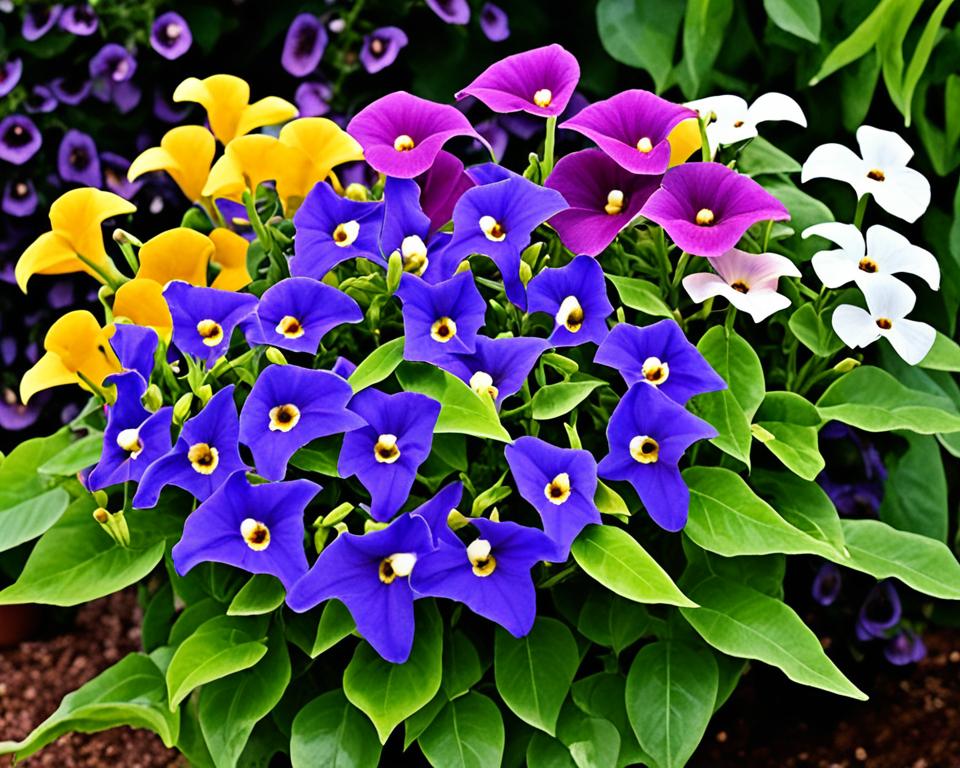
Thunbergia laurifolia in Different Cultures
The thunbergia laurifolia, also known as the purple glory vine, has charmed people in Southeast Asia. Its bright purple flowers and many uses have made it a key part of traditional arts and food. Communities all over its home region value this plant.
In Thailand, the thunbergia laurifolia is highly valued. Its purple flowers are a common theme in Thai art, found on textiles and ceramics. The leaves and stems are used in crafts like basket-weaving and making decorative wreaths.
Also, the thunbergia laurifolia is used in cooking in some parts of Southeast Asia. In Vietnam, its leaves and young shoots are used in stir-fries and vegetable dishes. They add a special flavor and texture to the food.
This plant also has deep symbolic meaning in some cultures. In Laos, it’s seen as having spiritual powers. It’s used in traditional rituals and ceremonies, showing the deep respect for nature in the region’s culture.
“The thunbergia laurifolia is a true ambassador of Southeast Asian culture, showcasing the region’s rich tapestry of traditions and the profound connection between people and the natural environment.”
The thunbergia laurifolia continues to interest gardeners and nature lovers around the world. Its lasting role in the cultures of its native lands shows its deep importance. It also highlights the lasting traditions it represents.
Frequently Asked Questions
Thunbergia laurifolia, also known as the purple glory vine or laurel-leaved clockvine, is a popular plant among gardeners and nature lovers. We’ve put together a list of common questions about this beautiful species.
What are the main uses of Thunbergia laurifolia?
People grow Thunbergia laurifolia for its vibrant purple flowers and lush green leaves. It’s great for landscaping as a climbing vine, ground cover, or standalone plant. Its medicinal uses are also well-known in traditional herbal remedies.
How do I care for Thunbergia laurifolia?
Thunbergia laurifolia loves warm, tropical weather and needs soil that drains well and is rich in nutrients. It needs full sun and regular watering when it’s growing. Using trellises or obelisks helps keep the plant tidy and encourages it to grow well.
Is Thunbergia laurifolia easy to propagate?
Yes, you can easily grow Thunbergia laurifolia from cuttings or seeds. Cut stems in the growing season and plant them in good soil. It also spreads on its own, making it easy to expand your garden.
Are there any pests or diseases to be aware of?
Thunbergia laurifolia is usually tough, but watch out for pests like aphids, mealybugs, and spider mites. Fungal diseases like powdery mildew and root rot can happen if it’s not cared for right. Good air flow and not overwatering can prevent these problems.
Can Thunbergia laurifolia be grown in containers?
Yes! Thunbergia laurifolia does well in pots, perfect for small gardens. Pick a pot with good drainage and use a mix that drains well and has nutrients. Don’t forget to provide a trellis or cage for the vine to climb and show off its flowers.
| Characteristic | Details |
|---|---|
| Botanical Name | Thunbergia laurifolia |
| Common Names | Purple glory vine, laurel-leaved clockvine |
| Plant Type | Climbing vine, ornamental |
| Flower Color | Purple, trumpet-shaped |
| Bloom Time | Spring to fall |
| Sun Exposure | Full sun |
| Soil Requirements | Well-drained, nutrient-rich |
| Hardiness Zones | 9-11 |
If you have more questions about Thunbergia laurifolia, talk to local gardening experts or check online resources. With the right care, your purple glory vine will flourish and add beauty to your garden.
Conclusion
Thunbergia laurifolia, also known as the purple glory vine, is a standout plant for warm-climate gardens. It’s known for its beauty, health benefits, and many uses. This tropical plant is a gem for gardeners and plant lovers.
Learning how to grow and choose different types of Thunbergia laurifolia lets you add this amazing vine to your garden easily. It can make your landscape look better, help with health, or just bring joy with its beautiful flowers.
Starting your adventure with Thunbergia laurifolia means embracing its special beauty and potential. With the right care, this vine will become a treasured part of your garden. It will bring beauty and benefits for many years.






